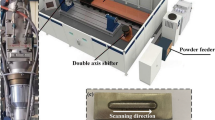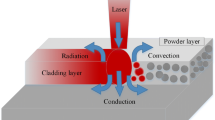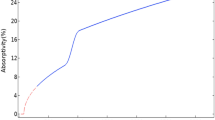Abstract
A finite element model of nanosecond laser interaction with the Cu-Al2O3 dispersion strengthened alloys has been established according to the underlying mechanism of melting flow, phase transition, and evaporation removal of material. Attempting to replicate the multi-field coupling effects in laser ablation process, this model takes both the thermophysical properties of materials varied with the temperature, and the evolution of erosion morphology under the instantaneous high-temperature action of pulsed laser into consideration. Moreover, the influence of coaction of diverse forces (including recoil pressure, surface tension, and Marangoni force), the phase transformation, and the melting flow of material on the laser processing were also integrated into the model. On the basis of the proposed model, a FEM simulation study on the distribution of temperature field, formation process of erosion morphology, and numerical prediction of ablation depth in laser processing was performed. The deviation of the predicted values of ablation depth from the experimental results under the same power condition as the simulations can be controlled within 13%, indicating that the proposed simulation model can be adopted to effectively predict the width of heat affected zone (HAZ) and the width of recast layer under specific processing parameters.














Similar content being viewed by others
References
Baig A, Gamzina D, Barchfeld R et al (2012) 0.22 THz wideband sheet electron beam traveling wave tube amplifier: cold test measurements and beam wave interaction analysis. Phys Plasmas 19(9):093110
Ryskin NM, Rozhnev AG, Starodubov AV et al (2018) Planar microstrip slow-wave structure for low-voltage V-band traveling-wave tube with a sheet electron beam. Ieee Electr Device L 39(5):757–760
Padmanabham G, Bathe R (2018) Laser materials processing for industrial applications. P Natl A Sci India A 88(3):359–374
Sharma A, Yadava V (2018) Experimental analysis of Nd-YAG laser cutting of sheet materials - a review. Opt Laser Technol 98:264–280
Dhakal B, Swaroop S (2018) Review: laser shock peening as post welding treatment technique. J Manuf Process 32:721–733
Duan W, Mei X, Fan Z et al (2020) Electrochemical corrosion assisted laser drilling of micro-hole without recast layer. Optik 202:163577
Duan W, Mei X, Fan Z et al (2021) Removal of recast layer in the laser drilled film cooling holes by a two-step inner streaming electrochemical technique. J Micromech Microeng 31(7):075006
Dhaker KL, Singh B, Shrivastava Y et al (2020) Experimental investigation and parametric optimisation of the hole-circularity and recast layer during the laser trepan drilling. Aust J Mech Eng 20(5):1349–1362
Dubey AK, Yadava V (2008) Laser beam machining - a review. Int J Mach Tool Manu 48(6):609–628
Lim HS, Yoo J (2011) FEM based simulation of the pulsed laser ablation process in nanosecond fields. J Mech Sci Technol 25(7):1811–1816
Vasantgadkar NA, Bhandarkar UV, Joshi SS (2010) A finite element model to predict the ablation depth in pulsed laser ablation. Thin Solid Films 519(4):1421–1430
Berényi R, Szaffner D (2015) FEM based 3D simulation of nanosecond UV laser ablation. 38th International Spring Seminar on Electronics Technology, Eger, pp 385–389
Wang Y, Shen N, Befekadu GK et al (2017) Modeling pulsed laser ablation of aluminum with finite element analysis considering material moving front. Int J Heat Mass Tran 113:1246–1253
Zhang J, Zhao L, Rosenkranz A et al (2019) Nanosecond pulsed laser ablation of silicon-finite element simulation and experimental validation. J Micromech Microeng 29(7):075009
Zhang Z, Zhang Q, Wang Q et al (2020) Investigation on the material removal behavior of single crystal diamond by infrared nanosecond pulsed laser ablation. Opt Laser Technol 126:106086
Zhao Z, Wang J, Du W et al (2023) Numerical simulation and experimental study of the 7075 aluminum alloy during selective laser melting. Opt Laser Technol 167:109814
Ma R, Peng C, Cai Z et al (2021) Finite element analysis of temperature and stress fields during selective laser melting process of Al–Mg–Sc–Zr alloy. T Nonferr Metal Soc 31(10):2922–2938
Zhou J, Shen H, Pan Y et al (2016) Experimental study on laser microstructures using long pulse. Opt Laser Eng 78:113–120
Yang X, Zhang Z, Zhang W (2022) Simulation of thermal behavior of selective laser melting high strength aluminum alloy. Laser Optoelectron P 59(23):2314003
Wu N, Zhai Z, Cui Y et al (2023) Numerical simulation and experimental analysis of machining morphology with pulsed laser. Opt Laser Technol 159:108952
Tan C, Zhao L, Chen M et al (2022) Heat accumulation effect during CO2 laser processing of fused silica optics[J]. Results Phys 34:105308
Li K, Zhou H, Zhao Z et al (2021) A study on transient molten pool dynamics in laser polishing of Ti6Al4V using numerical simulation. J Manuf Process 65:478–490
Sharma S, Mandal V, Ramakrishna SA et al (2018) Numerical simulation of melt hydrodynamics induced hole blockage in Quasi-CW fiber laser micro-drilling of TiAl6V4. J Mater Process Tech 262:131–148
Nedjar B (2002) An enthalpy-based finite element method for nonlinear heat problems involving phase change. Comput Struct 80(1):9–21
Dal M, Coste F, Schneider M et al (2019) Laser based method for surface tension and density measurements for liquid refractory metals (Nb, Ta, and W). J Laser Appl 31(2):022604
Zhang Y, Shen Z, Ni X (2014) Modeling and simulation on long pulse laser drilling processing. Int J Heat Mass Tran 73:429–437
Chan Y, Tien C (1985) A numerical study of two-dimensional laminar natural-convection in shallow open cavities. Int J Heat Mass Tran 28(3):603–612
Zhang C, Zhou J, Shen H (2017) Role of capillary and thermocapillary forces in laser polishing of metals. J Manuf Sci E-t Asme 139(4):041019
Voller VR, Prakash C (1987) A fixed grid numerical modeling methodology for convection diffusion mushy region phase-change problems. Int J Heat Mass Tran 30(8):1709–1719
Sharma S, Mandal V, Ramakrishna SA (2019) Numerical simulation of melt pool oscillations and protuberance in pulsed laser micro melting of SS304 for surface texturing applications. J Manuf Process 39:282–294
Vora HD, Santhanakrishnan S, Harimkar SP et al (2013) One-dimensional multipulse laser machining of structural alumina: evolution of surface topography. Int J Adv Manuf Tech 68(1–4):69–83
Zhang P, Zhang D, Liu Z, et al. (2018) Microscopic simulation of the effect of process parameters by the Marangoni convection on the temperature field of Inconel 718 alloy using selective laser melting. 2018 SPIE
Hirayama Y, Obara M (2003) Heat-affected zone evaluation of copper and iron metals induced by femtosecond laser ablation. The 16th Annual Meeting of the IEEE Lasers and Electro-Optics Society, Tucson, pp 483-484
Chen SH, Huang JH, Xia J et al (2015) Influence of processing parameters on the characteristics of stainless steel/copper laser welding. J Mater Process Tech 222:43–51
Li Y, Wang X (2020) Microstructure evolution of a simulated coarse-grained heat-affected zone of T23 steel during aging. Metall Mater Trans A 51(3):1183–1194
Chularis AA, Rzaev RA, Valisheva AG (2019) Evolution of mechanisms of plastic strain responsible for structure formation in near-weld zone under friction stir welding. Met Sci Heat Treat 61(1–2):57–63
Liu W, Wang L, Liu J, et al. (2008) Microstructures and toughness in simulated coarse grain heat-affected zones of copper-bearing steel. 2007 5th ICPNS 07
Jiang L, Pan C, Chen K et al (2015) Fiber laser carving under ice layer without laser energy attenuation. J Mater Process Tech 216:278–286
Chen SG, Lian M, Wu X et al (2021) Study on the micro-EDM processing characteristics of Ti-6Al-4V alloy with different electrode materials. Int J Adv Manuf Tech 116(11–12):3369–3376
Funding
This work was supported by National Natural Science Foundation of China (No. 52075128); Natural Science Foundation for Distinguished Young Scholars of Heilongjiang Province, China (No. YQ2020E013); and Opening Project of the Key Laboratory of Advanced Manufacturing and Intelligent Technology (Ministry of Education), Harbin University of Science and Technology.
Author information
Authors and Affiliations
Contributions
YW and ZM are graduate students. They performed the experimental and simulation work under supervision of Prof. CW and Prof. MC. HL, XW, CL, and XL helped to provide data support and typesetting optimization. All authors have equally contributed the manuscript.
Corresponding author
Ethics declarations
Competing interests
The authors declare no competing interests.
Additional information
Publisher's Note
Springer Nature remains neutral with regard to jurisdictional claims in published maps and institutional affiliations.
Rights and permissions
Springer Nature or its licensor (e.g. a society or other partner) holds exclusive rights to this article under a publishing agreement with the author(s) or other rightsholder(s); author self-archiving of the accepted manuscript version of this article is solely governed by the terms of such publishing agreement and applicable law.
About this article
Cite this article
Wang, Y., Wu, C., Ma, Z. et al. Numerical simulation study of ultraviolet nanosecond laser ablation of Cu-Al2O3 dispersion strengthened alloys. Int J Adv Manuf Technol 129, 2153–2169 (2023). https://doi.org/10.1007/s00170-023-12455-1
Received:
Accepted:
Published:
Issue Date:
DOI: https://doi.org/10.1007/s00170-023-12455-1




